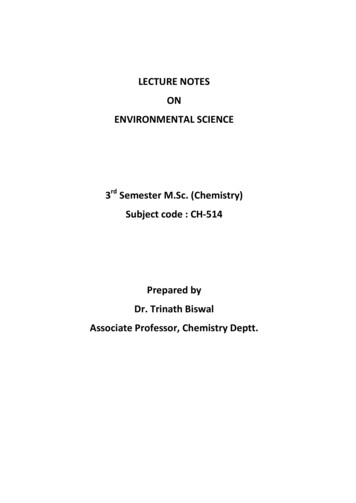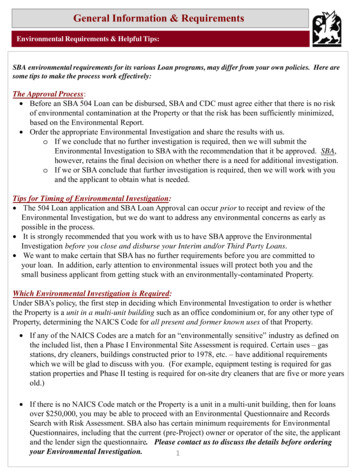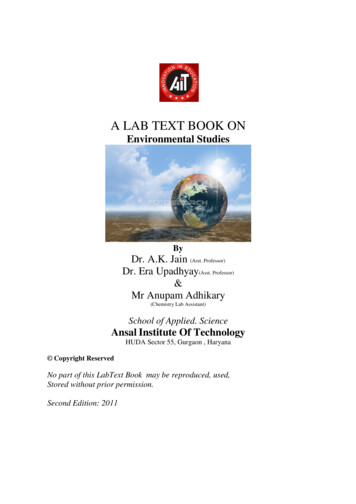
Transcription
LECTURE NOTESONENVIRONMENTAL SCIENCE3rd Semester M.Sc. (Chemistry)Subject code : CH-514Prepared byDr. Trinath BiswalAssociate Professor, Chemistry Deptt.
DISCLAIMERThis document does not claim any originality and cannot beused as a substitute for prescribed textbooks. Theinformation presented here is merely a collection by nments. Various sources as mentioned at the end of thedocument as well as freely available material from internetwere consulted for preparing this document. The ownershipof the information lies with the author or institutions.
MODULE -1AIR POLLUTION (CHAPTER-1)Introduction: Air pollution refers to the release of pollutants into the air that aredetrimental to human health and the planet as a whole. The Clean Air Act authorizes theU.S. Environmental Protection Agency (EPA) to protect public health by regulating theemissions of these harmful air pollutants. The NRDC has been a leading authority on thislaw since it was established in 197.Air pollution is a change in the physical, chemical andbiological characteristic of air that causes adverse effects on humans and otherorganisms. The ultimate result is a change in the natural environment and ecosystem.The substances that are responsible for causing air pollution are called air pollutants.These air pollutants can be either natural (e.g. wildfires) or synthetic (man-made); theymay be in the form of gas, liquid or solid.Types of Air Pollutants:An air pollutant is known as a substance in the air that can cause harm to humans and theenvironment. Pollutants can be in the form of solid particles, liquid droplets, or gases. Inaddition, they may be natural or man-made. Pollutants can be classified as either primaryor secondary. Usually, primary pollutants are substances directly emitted from a process,such as ash from a volcanic eruption, the carbon monoxide gas from a motor vehicleexhaust or sulphur dioxide released from factories.Secondary pollutants are not emitted directly. Rather, they form in the air when primarypollutants react or interact. An important example of a secondary pollutant is groundlevel ozone is one of the many secondary pollutants that causes photochemical smog.(1) Major primary pollutants produced by human activitySulphur oxides (SOx):SO2 is produced by volcanoes and in various industrial processes. Since coal andpetroleum often contain sulphur compounds, their combustion generates sulphurdioxide. Further oxidation of SO2, usually in the presence of a catalyst such as NO2,forms H2SO4, and thus acid rain. This is one of the causes for concern over theenvironmental impact of the use of these fuels as power sources.ii. Nitrogen oxides (NOx):Especially nitrogen dioxide is emitted from high temperature combustion.Nitrogen dioxide is the chemical compound with the formula N0 2. It is responsiblefor photochemical smog, acid rain etc.iii. Carbon monoxide:It is a colourless, odourless, non-irritating but very poisonous gas. It is a productby incomplete combustion of fuel such as natural gas, coal or wood. Vehicularexhaust is a major source of carbon monoxide.
iv. Carbon dioxide (CO2):A greenhouse gas emitted from combustion but is also a gas vital to livingorganisms. It is a natural gas in the atmosphere.v. Volatile organic compounds:VOCs are an important outdoor air pollutant. In this field they are often dividedinto the separate categories of methane (CH4) and non-methane (NMVOCs).Methane is an extremely efficient greenhouse gas which contributes to enhancedglobal warming.Other hydrocarbon VOCs are also significant greenhouse gases via their role increating ozone and in prolonging the life of methane in the atmosphere, althoughthe effect varies depending on local air quality. Within the NMVOCs, the aromaticcompounds benzene, toluene and xylene are suspected carcinogens and may leadto leukaemia through prolonged exposure. 1, 3-butadiene is another dangerouscompound which is often associated with industrial uses.vi. Particulate matter:Particulates alternatively referred to as particulate matter (PM) or fine particles,are tiny particles of solid or liquid suspended in a gas. In contrast, aerosol refers toparticles and the gas together. Sources of particulate matter can be manmade ornatural.Some particulates occur naturally, originating from volcanoes, dust storms, forestand grassland fires, living vegetation, and sea spray. Human activities, such as theburning of fossil fuels in vehicles, power plants and various industrial processesalso generate significant amounts of aerosols.Averaged over the globe, anthropogenic aerosols—those made by humanactivities—currently account for about 10 per cent of the total amount of aerosolsin our atmosphere. Increased levels of fine particles in the air are linked to healthhazards such as heart disease, altered lung function and lung cancer.vii. Persistent free radicals – connected to airborne fine particles could causecardiopulmonary disease.viii. Toxic metals – such as lead, cadmium and copper.ix. Chlorofluorocarbons (CFCs) – harmful to the ozone layer emitted fromproducts currently banned from use.x. Ammonia (NH3) – emitted from agricultural processes. Ammonia is a compoundwith the formula NH3. It is normally encountered as a gas with a characteristicpungent odour. Ammonia contributes significantly to the nutritional needs ofterrestrial organisms by serving as a precursor to foodstuffs and fertilizers.Ammonia, either directly or indirectly, is also a building block for the synthesis ofmany pharmaceuticals. Although in wide use, ammonia is both caustic andhazardous.xi. Odours – such as from garbage, sewage, and industrial processesxii. Radioactive pollutants – produced by nuclear explosions, war explosives, andnatural processes such as the radioactive decay of radon.Secondary pollutants include:
i. Particulate matter formed from gaseous primary pollutants and compounds inphotochemical smog. Smog is a kind of air pollution; the word “smog” is aportmanteau of smoke and fog. Classic smog results from large amounts of coalburning in an area caused by a mixture of smoke and sulphur dioxide. Modernsmog does not usually come from coal but from vehicular and industrial emissionsthat are acted on in the atmosphere by sunlight to form secondary pollutants thatalso combine with the primary emissions to form photochemical smog.ii. Ground level ozone (O3) formed from NOx and VOCs. Ozone (O3) is a keyconstituent of the troposphere (it is also an important constituent of certainregions of the stratosphere commonly known as the Ozone layer). Photochemicaland chemical reactions involving it drive many of the chemical processes thatoccur in the atmosphere by day and by night. At abnormally high concentrationsbrought about by human activities (largely the combustion of fossil fuel), it is apollutant, and a constituent of smog.iii. Peroxyacetyl nitrate (PAN) – similarly formed from NOx and VOCs and is adangerous air pollutant mostly affects our respiratory system and nervous system.Sources of Air Pollution:Sources of air pollution refer to the various locations, activities or factors which areresponsible for the releasing of pollutants in the atmosphere. These sources can beclassified into two major categories which are:1.Anthropogenic sources (human activity)It mostly related to burning different kinds of fuel:i. “Stationary Sources” include smoke stacks of power plants, manufacturing facilities(factories) and waste incinerators, as well as furnaces and other types of fuel-burningheating devices.ii. “Mobile Sources” include motor vehicles, marine vessels, aircraft and the effect ofsound etc.iii. Chemicals, dust and controlled burn practices in agriculture and forestry management.Controlled or prescribed burning is a technique sometimes used in forest management,farming, prairie restoration or greenhouse gas abatement. Fire is a natural part of bothforest and grassland ecology and controlled fire can be a tool for foresters. Controlledburning stimulates the germination of some desirable forest trees, thus renewing theforest.iv. Fumes from paint, hair spray, varnish, aerosol sprays and other solvents.v. Waste deposition in landfills, which generate methane. Methane is not toxic; however,it is highly flammable and may form explosive mixtures with air. Methane is also anasphyxiate and may displace oxygen in an enclosed space. Asphyxia or suffocation mayresult if the oxygen concentration is reduced to below 19.5% by displacement.
v. Military, such as nuclear weapons, toxic gases, germ warfare and rocketry.2.Natural sources:i. Dust from natural sources, usually large areas of land with little or no vegetation.ii. Methane, emitted by the digestion of food by animals, for example cattle.iii. Radon gas from radioactive decay within the Earth’s crust. Radon is a colourless,odourless, naturally occurring, radioactive noble gas that is formed from the decay ofradium. It is considered to be a health hazard. Radon gas from natural sources canaccumulate in buildings, especially in confined areas such as the basement and it is thesecond most frequent cause of lung cancer, after cigarette smoking.iv. Smoke and carbon monoxide from wildfires.v. Volcanic activity, which produce sulphur, chlorine, and ash particulates.Effects and fate of Air Pollutants:There are Various Harmful Effects of the air Pollutants:i. Carbon monoxide (source- Automobile exhaust, photochemical reactions in theatmosphere, biological oxidation by marine organisms, etc.)- Affects the respiratoryactivity as haemoglobin has more affinity for CO than for oxygen. Thus, CO combines withHB and thus reduces the oxygen-carrying capacity of blood. This results in blurred vision,headache, unconsciousness and death due to asphyxiation (lack of oxygen).ii. Carbon di oxide (source- Carbon burning of fossil fuels, depletion of forests (thatremove excess carbon dioxide and help in maintaining the oxygen-carbon dioxide ratio) –causes global warming.iii. Sulphur dioxide (source- Industries, burning of fossil fuels, forest fires, electricgeneration plants, smelting plants, industnal boilers, petroleum refineries and volcaniceruptions)- Respiratory problems, severe headache, reduced productivity of plants,yellowing and reduced storage time for paper, yellowing and damage to limestone andmarble, damage to leather, increased rate of corrosion of iron, steel, zinc and aluminium.iv. Hydrocarbons Poly-nuclear Aromatic Compounds(PAC) and Poly-nuclear AromaticHydrocarbons(PAH) (source- Automobile exhaust and industries, leaking fuel tanks,leaching from toxic waste dumping sites and coal tar lining of some water supply pipes)Carcinogenic (may cause leukaemia).v. Chloro-fluoro carbons (CFCs) (source- Refrigerators, air conditioners, foam shavingcream, spray cans and cleaning solvents)- Destroy ozone layer which then permitsharmful UV rays to enter the atmosphere. The ozone layer protects the earth from theultraviolet rays sent down by the sun. If the ozone layer is depleted by human action, theeffects on the planet could be catastrophic.
vi. Nitrogen Oxides (source- Automobile exhausts, burning of fossil fuels, forest fires,electric generation plants, smelting plants, industrial boilers, petroleum refineries andvolcanic eruptions)- Forms photochemical smog, at higher concentrations causes leafdamage or affects the photosynthetic activities of plants and causes respiratory problemsin mammals.vii. Particulate matter Lead halides (lead pollution) (source- Combustion of leadedgasoline products) , Toxic effect in man.viii. Asbestos particles (source- Mining activities) – Asbestosis – a cancerous disease ofthe lungs.ix. Silicon dioxide (source- Stone cutting, pottery, glass manufacturing and cementindustries) Silicosis, a cancerous disease.x. Mercury (source- combustion of fossil fuel & plants)-brain & kidney damage.Air pollutants affect plants by entering through stomata (leaf pores through which gasesdiffuse), destroy chlorophyll and affect photosynthesis. During the day time the stomataare wide open to facilitate photosynthesis. Air pollutants during day time affect plants byentering the leaf through these stomata more than night.Pollutants also erode waxy coating of the leaves called cuticle. Cuticle prevents excessivewater loss and damage from diseases, pests, drought and frost. Damage to leaf structurecauses necrosis (dead areas of leaf), chlorosis (loss or reduction of chlorophyll causingyellowing of leaf) or epinasty (downward curling of leaf), and abscission (dropping ofleaves).Particulates deposited on leaves can form encrustations and plug the stomata and alsoreduce the availability of sunlight. The damage can result in death of the plant. S02 causesbleaching of leaves, chlorosis, injury and necrosis of leaves. N02 results in increasedabscission and suppressed growth. O3 causes flecks on leaf surface, premature aging,necrosis and bleaching.Peroxyacetyl nitrate (PAN) causes silvering of lower surface of leaf, damage to young andmore sensitive leaves and suppressed growth. Fluorides cause necrosis of leaf-tip whileethylene results in epinasty, leaf abscission and dropping of flowers.4. Control of Air Pollution:The following items are commonly used as pollution control devices by industry ortransportation devices. They can either destroy contaminants or remove them from anexhaust stream before it is emitted into the atmosphere.i. Particulate Control:Mechanical collectors (dust cyclones, multi-cyclones)- Cyclonic separation is a method ofremoving particulates from an air, gas or water stream, without the use of filters, through
vortex separation. Rotational effects and gravity are used to separate mixtures of solidsand fluids.A high speed rotating (air) flow is established within a cylindrical or conical containercalled a cyclone. Air flows in a spiral pattern, beginning at the top (wide end) of thecyclone and ending at the bottom (narrow) end before exiting the cyclone in a straightstream through the centre of the cyclone and out the top.Larger (denser) particles in the rotating stream have too much inertia to follow the tightcurve of the stream and strike the outside wall, falling then to the bottom of the cyclonewhere they can be removed.In a conical system, as the rotating flow moves towards the narrow end of the cyclonethe rotational radius of the stream is reduced, separating smaller and smaller particles.The cyclone geometry, together with flow rate, defines the cut point of the cyclone. Thisis the size of particle that will be removed from the stream with 50% efficiency. Particleslarger than the cut point will be removed with a greater efficiency and smaller particleswith a lower efficiency.ii. Electrostatic Precipitators:An electrostatic precipitator (ESP), or electrostatic air cleaner is a particulate collectiondevice that removes particles from a flowing gas (such as air) using the force of aninduced electrostatic charge. Electrostatic precipitators are highly efficient filtrationdevices that minimally impede the flow of gases through the device, and can easilyremove fine particulate matter such as dust and smoke from the air stream.In contrast to wet scrubbers which apply energy directly to the flowing fluid medium, anESP applies energy only to the particulate matter being collected and therefore is veryefficient in its consumption of energy (in the form of electricity).iii. Particulate Scrubbers:The term Wet scrubber describes a variety of devices that remove pollutants from afurnace flue gas or from other gas streams. In a wet scrubber, the polluted gas stream isbrought into contact with the scrubbing liquid, by spraying it with the liquid, by forcing itthrough a pool of liquid, or by some other contact method, so as to remove thepollutants.The design of wet scrubbers or any air pollution control device depends on the industrialprocess conditions and the nature of the air pollutants involved. Inlet gas characteristicsand dust properties (if particles are present) are of primary importance.Scrubbers can be designed to collect particulate matter and/or gaseous pollutants. Wetscrubbers remove dust particles by capturing them in liquid droplets. Wet scrubbersremove pollutant gases by dissolving or absorbing them into the liquid.Any droplets that are in the scrubber inlet gas must be separated from the outlet gasstream by means of another device referred to as a mist eliminator or entrainment
separator (these terms are interchangeable). Also, the resultant scrubbing liquid must betreated prior to any ultimate discharge or being reused in the plant:i. Vehicular pollution can be checked by regular tune-up of engines; replacement of morepolluting old vehicles; installing catalytic converters; by engine modification to have fuelefficient (lean) mixtures to reduce CO and hydrocarbon emissions; and slow and coolerburning of fuels to reduce NOx emission.ii. Using low sulphur coal in industries.iii. Minimise or modify activities which cause pollution e.g. transportation and energyproduction.Global Warming and Greenhouse EffectThe history of the greenhouse effect and global warming. First of all, predicted by SvanteArrhenius was a Swedish scientist that was the first to claim in 1896 that fossil fuelcombustion may eventually result in enhanced global warming. He proposed a relationbetween atmospheric carbon dioxide concentrations and temperatureWhen we burn organic materials (i.e. carbon-containing) fuels, or organic matterdecomposes, carbon dioxide is released into the air. It is transparent to incoming solarradiation, but opaque to some wavelengths of heat radiated from the warmed surface ofthe Earth, and so traps heat, leading eventually to a warming of the lower atmosphere”This is known as the greenhouse effect, as in principle, the atmosphere behaves in asimilar manner to a garden greenhouse, it allows sunlight to penetrate, but heat istrapped within the atmosphere in the same way that it is trapped within the glass walls ofa greenhouse. This trapped hot air is causing the earth to heat up, resulting in globalwarming, and ultimately climate change.Greenhouse gases include naturally occurring gases, such as carbon dioxide, methane,and even water vapor. In fact, water vapor is the most abundant greenhouse gas.However, human activities, such as burning of coal, exhaust fumes from vehicles, andburning of trees during deforestation activities, are contributing huge amountsof additional greenhouse gases into the atmosphere, where they enhance the greenhouseeffect further and contribute to global warming.The Albedo EffectSnowcapped mountains and ice sheets reflect radiation away from the Earth which is aphenomenon that is known as the albedo effect. This helps reduce the amount of heatabsorbed by the Earth, and therefore plays a vital role in keeping the Earth cool.When ice sheets melt, it exposes dark rock or vegetation that doesn’t have the samereflective properties as ice, and thus tends to absorb rather than reflect heat.Life sustains on Earth by depending on the energy coming from the sun. About 60percent of the energy and light reaching the surface of the Earth passes through the airand clouds where the harmful gases get segregated and absorbed. These gases areradiated upwards in the form of infrared heat. About 89 percent of this heat is then takenby the greenhouse gases and radiated back to the surface. Due to depletion of the ozone
layer and global warming, the greenhouse effect has become the primary reason forwhich the Earth surface now radiates more heat than it usually should.Greenhouse GasesOur planets contain many gases which surface a layer and prevent unwanted radiationsto reach the surface. These gases are in certain proportions breaking which, thecomponents get disturbed. The greenhouse gas absorbs and emits these radiations withinthe range which ultimately causes the greenhouse effect. The common greenhouse gasesin Earth’s atmosphere are:1. Water vapor (H2O)2. Carbon dioxide (CO2)3. Methane (CH4)4. Nitrous oxide (N2O)5. Ozone (O3)6. Chlorofluorocarbons (CFCs)Causes of Global warmingWith the coming of Industrial revolutions, the use of chemicals and fuel in the factorieshas increased to a dangerous amount. Along with it, deforestation due to industrial oreconomic purposes and the excess burning of fossil fuels like natural gas, oil, and coal,has increased the concentration of atmospheric carbon dioxide from 315 ppm (part permillion by volume) to about 363 ppm since 1958. These are some of the primary reasonsfor which the heat gets trapped in the atmosphere thus causing global warming.The greenhouse effect is caused by the interaction of the sun's energy with greenhousegases such as carbon dioxide, methane, nitrous oxide and fluorinated gases in the Earth'satmosphere. The ability of these gases to trap heat is what causes the greenhouse effect.Greenhouse gases are made of three or more atoms. This molecular structure makes itpossible for these gases to trap heat in the atmosphere and then re-emit it towards thesurface which further warms the Earth. This continuous cycle of trapping heat leads to an
overall increase in global temperatures. This process, which is very similar to the way agreenhouse works, is why the gases that can produce this effect are collectively known asgreenhouse gases.The principal forcing gases of the greenhouse effect are:Carbon dioxide (CO2) Methane (CH4) Nitrous oxide (N2O) Fluorinated gasesCarbon dioxide, methane, nitrous oxide and the fluorinated gases are all well-mixed gasesin the atmosphere that do not react to changes in temperature and air pressure, so thelevels of these gases are not affected by condensation. Water vapor on the other hand, is ahighly active component of the climate system that responds rapidly to changes inconditions by either condensing into rain or snow, or evaporating to return to theatmosphere.Carbon dioxide and the other non-condensing greenhouse gases are the key gases withinthe Earth's atmosphere that sustain the greenhouse effect and control its strength. Watervapor is a fast-acting feedback but its atmospheric concentration is controlled by theradiative forcing supplied by the non-condensing greenhouse gases.Consequences of Global warmingWarmer climate: On average, the Earth’s temperature will become warmer thanearlier, while some places will get warm while others may not The rise of sea level: Due to global warming, the glaciers and ice sheets of Greenlandand Atlantic will melt which will add water to the sea level, thus causing manydisasters like Tsunami. A rise in sea level will also have an economic impact especiallyon the low-lying coastal areas and islands causing unavoidable soil erosion. Agricultural impact: According to multiple experiments, with the high concentrationof CO2 in the atmosphere, the growth of crops is twice than the normal growth. At thesame time, the shifting of the climatic pattern may change the areas where crops growfaster and better thus affecting the normal amount of agricultural production. Environmental effect; The greenhouse effect is a major factor in keeping the Earthwarmer because it keeps some of the planet's heat that would otherwise escape fromthe atmosphere out to space. In fact, without the greenhouse effect the Earth's averageglobal temperature would be much colder and life on Earth would not be possibleWorking principle of Greenhouse effect To understand exactly how the greenhouse effect works, imagine the following: a warm,sunny day where the sun shines bright on the Earth. This sunlight (shortwave radiation)passes into the planet's atmosphere and warms the Earth. Part of this energy is absorbedby the Earth's surface, transformed into heat (long wave radiation) and radiated backtowards space. But as this heat goes up through the atmosphere, some of it is trapped bythe different greenhouse gases and doesn't escape into space. This in turn warms up theEarth's atmosphere; just like the windows of a greenhouse that lets light in and keeps theheat within to warm the plants growing inside.
Since some of the heat can't escape into space, it continues to add up which then warmsup the Earth. This is what we call the greenhouse effect. So the more greenhouse gasesyou have in the atmosphere, the more heat stays on Earth.If the amount of energy from the sun and the amount of greenhouse gases in theatmosphere remain the same, then the average temperature on Earth will also be constant.But this is no longer the case. The amount of greenhouse gases in our atmosphere is thehighest it has been in the last 3 million years.5 6 This is enhancing the greenhouse effectand making the Earth warmer than normal, which is affecting the planet's weatherpatterns, creating global warming and climate change.Energy in and energy outThere's a delicate balancing act occurring every day all across the Earth, involving theradiation the planet receives from space and the radiation that's reflected back out tospace.Earth is constantly bombarded with enormous amounts of radiation, primarily from thesun. This solar radiation strikes the Earth's atmosphere in the form of visible light, plusultraviolet (UV), infrared (IR) and other types of radiation that are invisible to the humaneye.UV radiation has a shorter wavelength and a higher energy level than visible light, whileIR radiation has a longer wavelength and a weaker energy level. About 30 percent of theradiation striking Earth's atmosphere is immediately reflected back out to space byclouds, ice, snow, sand and other reflective surfaces, according to NASA. The remaining70 percent of incoming solar radiation is absorbed by the oceans, the land and theatmosphere. As they heat up, the oceans, land and atmosphere release heat in the form ofIR thermal radiation, which passes out of the atmosphere and into space.
It's this equilibrium of incoming and outgoing radiation that makes the Earth habitable,with an average temperature of about 59 degrees Fahrenheit (15 degrees Celsius),according to NASA. Without this atmospheric equilibrium, Earth would be as cold andlifeless as its moon, or as blazing hot as Venus. The moon, which has almost noatmosphere, is about minus 243 F (minus 153 OC) on its dark side. Venus, on the otherhand, has a very dense atmosphere that traps solar radiation; the average temperature onVenus is about 864 F or 462o C.Control of global WarmingWe can't realistically stop the rise of CO2 in the near term, but we can slow it andtherefore reduce the consequences that will occur. More fuel-efficient cars, less frivolousdriving, more use of mass transit, improved insulation to decrease the fuel burned to heatand cool our homes, more efficient appliances, use of fluorescent rather than incandescentlight bulbs, and careful monitoring of home electricity usage (turn off the lights and TVwhen not using them) can reduce our energy needs. Conversion to alternatives like windand solar power which don't burn fossil fuels and emit CO2 into the atmosphere. Plantinglarge areas with trees will consume CO2 as the trees grow, until the forests mature.Stopping deforestation in the tropical forests around the world, especially in the Amazonand Indonesian rain forests, will keep that carbon in the forest rather than sending it backinto the atmosphere as the trees are burned or decay and are not replaced by more. Othertechniques have also been proposed such as the chemical removal of CO2 fromsmokestacks and burial in deep underground reservoirs, though only certain areas canbenefit from this, or disposal in the deep ocean where they will form a semi-stablecompound under the cold temperatures and high pressures, though the CO2 could tooeasily come bubbling back up. These latter solutions are not well studied and wouldn't beespecially cheap.Moreover, leaders, societies, communities, local planners, farmers, health organizations,need to recognize the changing climate and rising sea level as they make plans for thefuture. Our citizens need to be educated as to likely changes and how best to deal withthe changing conditions.ACID RAIN AND ITS EFFECTAbout Acid RainAcid rain refers to a mixture of deposited material, both wet and dry, coming from theatmosphere containing more than normal amounts of nitric and sulfuric acids. Simplyput, it means rain that is acidic in nature due to the presence of certain pollutants in theair due to cars and industrial processes. It is easily defined as rain, fog, sleet or snow thathas been made acidic by pollutants in the air as a result of fossil fuel and industrialcombustions that mostly emits Nitrogen Oxides (NOx) and Sulfur Dioxide (SO2). Acidityis determined on the basis of the pH level of the water droplets. Normal rain water isslightly acidic with a pH range of 5.3-6.0, because carbon dioxide and water present in theair react together to form carbonic acid, which is a weak acid. When the pH level of rainwater falls below this range, it becomes acid rain.When these gases react with water molecules and oxygen among other chemicals foundin the atmosphere, mild acidic chemical compounds such as sulfuric and nitric acid areformed resulting to acid rain. Acid rain generally leads to weathering of buildings,corrosion of metals, and peeling of paints on surfaces. Erupting volcanoes contains somechemicals that can cause acid rain. Apart from this, burning of fossil fuels, running
of factories and automobiles due to human activities are few other reasons behind thisactivity.Presently, large amounts of acid deposition is witnessed in the southeastern Canada,northeastern United States and most of Europe, including portions of Sweden, Norway,and Germany. In addition, some amount of acid deposition is found in parts of SouthAsia, South Africa, Sri Lanka, and Southern India.Forms of Acid RainThere are two forms in which acid deposition occurs – wet a
LECTURE NOTES ON ENVIRONMENTAL SCIENCE 3rd Semester M.Sc. (Chemistry) Subject code : CH-514 Prepared by Dr. Trinath Biswal Associate Professor, Chemistry Deptt. DISCLAIMER This document does not claim any originality and can










